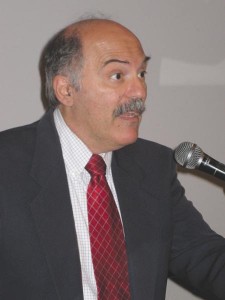Andrew Esguerra
Staff Writer

Photo: Ali Peyvandi
International Education Week, aimed at recognizing international diversity and celebrated on many university campuses across the nation, kicked off at Fresno State on Monday, November 15. One of the first events held was a lecture by Professor Barlow Der Mugrdechian of the Armenian Studies Program, entitled “Armenia at 19: Reflections” which offered a personal retrospective of Armenia’s history for the past 30 years, specifically his observations of Armenia’s changes and evolution since his first of many trips there in June 1978.
Dr. Berta Gonzalez, Associate Vice-President for Continuing and Global Education, welcomed the audience to the presentation. Dr. Sergio La Porta then introduced Prof. Der Mugrdechian.
During Prof. Der Mugrdechian’s first trip in 1978, Armenia was under Soviet rule. Even before that, during the course of the 20th century, Armenia had faced issues with rocky leadership and other political and environmental concerns, a few of which Prof. Der Mugrdechian highlighted in his lecture. Videos from Armenia taken by Prof. Der Mugrdechian in the summer of 2007 ushered in his talk. The videos showed Armenia changing, reconstructing, and being stagnant — vistas and buildings in shambles and preserved.
Pictures of ruins in Armenia told the tumultuous story of how the nation emerged in 1918 from the devastation of the Genocide, to become a short-lived first Armenian Republic. The Wilsonian Grant promised large amounts of land to the Armenians, which would have geographically doubled the size of Armenia, but it did not pan out. Nationalist Turkey did not accept the Treaty of Sevres and subsequently the Treaty dissolved. In that same year, 1920, the communist army invaded Armenia, transforming it into a part of the future USSR, where it remained from 1920 until 1991.
Armenia under Soviet rule was oppressed, but not broken; Armenians still expressed their strong beliefs and opinions. Although illegal to gather in groups larger than two, almost half a million Armenians gathered regularly at the Opera Square in Yerevan in 1988 to protest Azerbaijan’s administration of the region of Karabagh, which had a population that was 95% Armenian. Photographs taken of the large numbers of protesters were astounding. Some Fresno State students who were in Armenia in 1988, on a trip under the direction of Prof. Der Mugrdechian, were eyewitnesses to the tireless Armenian spirit in action.
In the USSR, Armenia was the epicenter of chemical production and the factories did not conscientiously manage their waste, which raised environmental concerns. Safety issues at the nuclear power plant at Medzamor became especially important after the Chernobyl nuclear disaster in 1986.
Prof. Der Mugrdechian explained that in December of 1988, Armenia’s infamous earthquake struck at 11:41 in the morning, centered in Spitak. The magnitude 6.9 quake left rubble and devastation, due to the Soviets “taking shortcuts when building.” Structures shortchanged of building materials were left demolished. A slideshow of apartment buildings and churches in ruins played as Prof. Der Mugrdechian said that even to this day, not all the buildings have been rebuilt nor have ruins been completely cleaned. He also played a video clip of temporary housing for survivors of the earthquake from a more recent trip to Armenia to show the unfortunate state and trials of the Armenian people.
Illustrating the changes since the 1991 referendum that made Armenia an independent Republic, Prof. Der Mugrdechian continued explaining how perseverance and charity have propelled Armenia through good times and bad. Issues facing the new nation ranged from economic problems to environmental concerns. Today, some locations where destroyed churches once stood are being considered for new churches. No longer are Stalin’s purges killing Armenian nationals nor is harmful chemical waste being carelessly discarded. Karabagh (and its still largely Armenian population) is still attempting to maintain its independence from Azerbaijan.
Coming off of an economic boom earlier in the decade, Armenia also experienced a recession. Even with setbacks, Armenia has remained resilient. Yerevan State University teaches 10,000 students a year. More churches have been built or renovated and are now available to the people. Construction projects continue to modernize and advance the major cities.
Generosity from beyond Armenia’s borders has had a profound effect on the face of the country. The Holy Trinity Church in Yerevan was constructed due to the generosity of the Manoogian family. Varaz Samuelian willed money to build a cultural center in the city of Artik, aimed at inspiring artistic youths.
Recently, Zvartnots Airport has even gotten a major facelift. When Prof. Der Mugrdechian returns to Armenia this summer with another group of students, they’ll see another step in the evolution of the Armenian nation. Who knows what wonders will come from Armenia in the next 20 years?
 Hye Sharzhoom Armenian Action
Hye Sharzhoom Armenian Action